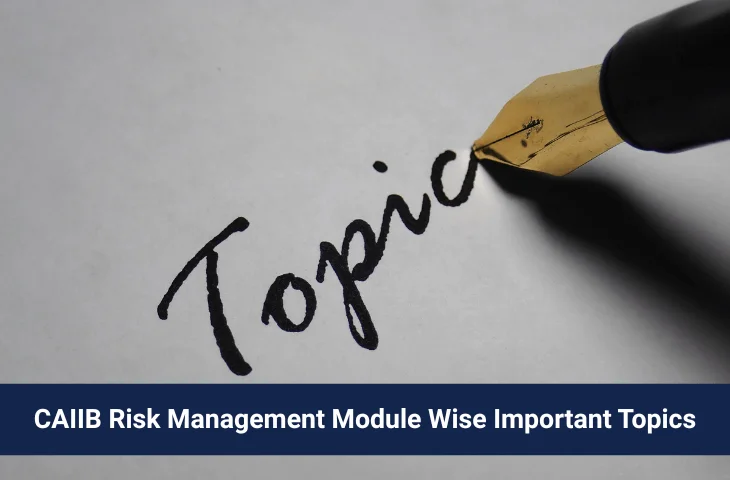The CAIIB (Certified Associate of Indian Institute of Bankers) is a prestigious professional banking exam conducted by the Indian Institute of Banking & Finance (IIBF). Among its elective papers, Risk Management is a critical choice for bankers focused on credit, market, operational, and treasury risks, along with regulatory compliance and financial risk mitigation strategies.
In this blog, we provide the most important topics for the Risk Management elective paper, module-wise breakdown, estimated weightage, and preparation insights based on past trends and IIBF examination patterns.
CAIIB Risk Management Important Topics
The module-wise breakdown of important topics is as follows:
| Module | Important Topics |
| Module A – Risk & Risk Management Framework | 1. Overview of Risk & Types of Risks (Credit, Market, Operational, Liquidity, etc.) 2. Why Banks are Special – Unique Risk Profile of Banks 3. Risk Management Framework at Banks 4. Asset-Liability Management (ALM) 5. Interest Rate Risk on Banking Book 6. Liquidity Risk Management 7. Organizational Structure & Governance in Risk Management (Board, ALCO, Committees) |
| Module B – Credit Risk Management | 8. Credit Risk Framework & Policies 9. Obligor & Borrower Risk Analysis 10. Credit Rating Systems & RBI Guidelines 11. Portfolio Risk Management 12. Credit Risk Measurement Models 13. Credit Derivatives and Risk Mitigation Tools |
| Module C – Market Risk | 14. Introduction to Market Risk 15. Fixed Income Securities & Interest Rate Risk 16. Measurement Tools: Value at Risk (VaR), Duration 17. Trading vs Banking Book Risks 18. Hedging Strategies using Derivatives |
| Module D – Operational Risk | 19. Operational Risk & Management Framework 20. Internal & External Loss Data Collection 21. Risk & Control Self-Assessment (RCSA) 22. Key Risk Indicators (KRIs) 23. Technology Risk, Corporate Governance, Climate Risk & Sustainable Finance |
| Module E – Basel & RBI Guidelines | 24. Need for Banking Regulations & Post-Crisis Reforms 25. Basel Framework: Basel I, II & III 26. Pillars of Basel – Minimum Capital, Supervisory Review, Market Discipline 27. Regulatory Capital & Capital Allocation (Tier 1, 2, 3) 28. Stress Testing & PCA Framework 29. Risk-Based Supervision & Internal Audit |
| Module F – Derivatives & Risk Management | 30. Usage of Derivatives in Risk Mitigation 31. Forward Contracts, Futures, Options, Swaps 32. Hedging Market, Credit, and Treasury Risks |
Also Check: Which Elective Paper to Choose for CAIIB
CAIIB Risk Management Module-wise Weightage
Based on past exams and expert insights, the estimated weightage of modules is:
| Module | Estimated Weightage (%) |
| Module A | 15–20 |
| Module B | 25–30 |
| Module C | 15–20 |
| Module D | 15–20 |
| Module E | 15–20 |
| Module F | 5–10 |
CAIIB Risk Management Exam Structure
The Risk Management elective is conducted online by IIBF and consists of multiple-choice questions, scenario-based questions, and some numerical-based questions.
| Feature | Details |
| Total Questions | 100 objective-type MCQs |
| Total Marks | 100 |
| Case-Based Questions | Includes scenarios from banking operations & risk mitigation |
| Numerical Questions | Limited, mainly from credit, market, and ALM calculations |
| Exam Mode | Online (Computer-Based Test) |
| Negative Marking | No negative marking |
| Exam Language | English / Hindi |
Preparation Strategy for Risk Management Elective
Risk Management requires both conceptual clarity and practical understanding of banking risks, regulatory frameworks, and risk mitigation tools.
- Focus on High-Weightage Modules: Prioritize Credit Risk (Module B) and Market Risk (Module C) for maximum scoring.
- Understand Regulatory Guidelines: Prepare thoroughly for Basel & RBI norms, stress testing, capital allocation, and supervisory review processes.
- Operational Risk & Governance: Emphasize RCSA, KRIs, internal/external loss data, corporate governance, and sustainable finance frameworks.
- Derivatives for Risk Mitigation: Learn applications of forwards, futures, options, and swaps in hedging credit, market, and treasury risks.
- Integrate BFM Knowledge: If you have studied Banking & Financial Management (BFM), link treasury and ALM modules with Risk Management concepts for a dual benefit.
- Practice Case Studies & MCQs: Apply theory to practical banking scenarios. Focus on past exam trends and question framing from Macmillan book references.
- Revise Regularly: Consolidate key risk frameworks, measurement tools, and regulatory guidelines.
FAQs
A: Module B (Credit Risk) and Module C (Market Risk).
A: Yes, forwards, futures, options, and swaps are crucial for risk mitigation scenarios.
A: Understand the risk type, bank’s framework, Basel norms, and practical mitigation strategies.
A: Limited; mainly on ALM, credit exposure, and market risk calculations.
A: Yes, integrating treasury and ALM modules from BFM helps reinforce your Risk Management preparation.
- CAIIB ABM Exam Analysis 2025, All Shifts, 30th November
- Difference Between JAIIB & CAIIB, Eligibility, Exam Pattern
- CAIIB ABFM Module-Wise Preparation Tips & Tricks, Check Details
- CAIIB Risk Management Important Topics, Module-wise Weightage
- CAIIB Rural Banking Module-wise Important Topics
- CAIIB HRM Elective Paper Important Topics and Preparation Strategy

Hi, I’m Aditi. I work as a Content Writer at Oliveboard, where I have been simplifying exam-related content for the past 4 years. I create clear and easy-to-understand guides for JAIIB, CAIIB, and UGC exams. My work includes breaking down notifications, admit cards, and exam updates, as well as preparing study plans and subject-wise strategies.
My goal is to support working professionals in managing their exam preparation alongside a full-time job and to help them achieve career growth.
